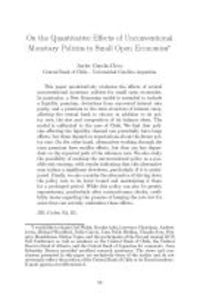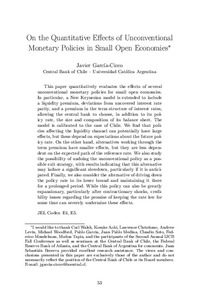Por favor, use este identificador para citar o enlazar este ítem:
https://repositorio.uca.edu.ar/handle/123456789/2297| Campo DC | Valor | Lengua/Idioma |
|---|---|---|
| dc.contributor.author | García Cicco, Javier | es |
| dc.coverage.spatial | CHILE | es |
| dc.date.accessioned | 2019-05-13T17:12:32Z | - |
| dc.date.available | 2019-05-13T17:12:32Z | - |
| dc.date.issued | 2011 | - |
| dc.identifier.citation | García Cicco, J. (2011). On the quantitative effects of unconventional monetary policies in small open economies [en línea]. En International Journal of Central Banking 7(1). Disponible en: http:https://repositorio.uca.edu.ar/handle/123456789/2297 | es |
| dc.identifier.uri | https://repositorio.uca.edu.ar/handle/123456789/2297 | - |
| dc.description.abstract | This paper quantitatively evaluates the effects of several unconventional monetary policies for small open economies. In particular, a New Keynesian model is extended to include a liquidity premium, deviations from uncovered interest rate parity, and a premium in the term structure of interest rates, allowing the central bank to choose, in addition to its policy rate, the size and composition of its balance sheet. The model is calibrated to the case of Chile. We find that policies affecting the liquidity channel can potentially have large effects, but these depend on expectations about the future policy rate. On the other hand, alternatives working through the term premium have smaller effects, but they are less dependent on the expected path of the reference rate. We also study the possibility of undoing the unconventional policy as a possible exit strategy, with results indicating that this alternative may induce a significant slowdown, particularly if it is anticipated. Finally, we also consider the alternative of driving down the policy rate to its lower bound and maintaining it there for a prolonged period. While this policy can also be greatly expansionary, particularly after contractionary shocks, credibility issues regarding the promise of keeping the rate low for some time can severely undermine these effects... | es |
| dc.format | application/pdf | es |
| dc.language | eng | es |
| dc.language.iso | eng | es |
| dc.publisher | Banco Central de Chile | es |
| dc.rights | Acceso Abierto | es |
| dc.rights.uri | https://creativecommons.org/licenses/by-nc-sa/4.0/ | es |
| dc.source | International Journal of Central Banking, Vol. 7, Nº 1, 2011 | es |
| dc.subject | POLITICA MONETARIA | es |
| dc.subject | ECONOMIA ABIERTA | es |
| dc.subject | MODELOS | es |
| dc.subject | LIQUIDEZ | es |
| dc.title | On the quantitative effects of unconventional monetary policies in small open economies | es |
| dc.type | Artículo | es |
| uca.path | Facultad de Ciencias Económicas|Departamento de Investigación "Francisco Valsecchi"|Artículos | es |
| uca.disciplina | ECONOMIA | es |
| uca.filename | /home/data-uca-generic/folder_generic/Departamento Francisco Valsecchi/Articulos/quantitative-effects-unconventional/metadata.xml | es |
| uca.issnrd | 1 | es |
| uca.affiliation | Fil: García Cicco, Javier. Pontificia Universidad Católica Argentina; Argentina | es |
| uca.affiliation | Fil: García Cicco, Javier. Banco Central de Chile; Chile | es |
| uca.version | publishedVersion | es |
| item.grantfulltext | open | - |
| item.fulltext | With Fulltext | - |
| item.languageiso639-1 | en | - |
| Aparece en las colecciones: | Artículos | |
Ficheros en este ítem:
| Fichero | Descripción | Tamaño | Formato | |
|---|---|---|---|---|
| quantitative-effects-unconventional.jpg | 5,29 kB | JPEG |  Visualizar/Abrir | |
| quantitative-effects-unconventional.pdf | 1,88 MB | Adobe PDF |  Visualizar/Abrir |
Visualizaciones de página(s)
97
comprobado en 27-abr-2024
Descarga(s)
47
comprobado en 27-abr-2024
Google ScholarTM
Ver en Google Scholar
Este ítem está sujeto a una Licencia Creative Commons

